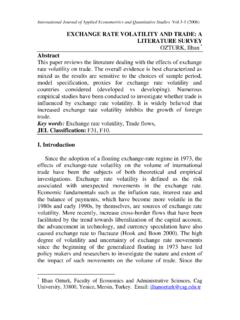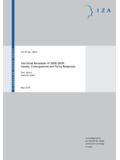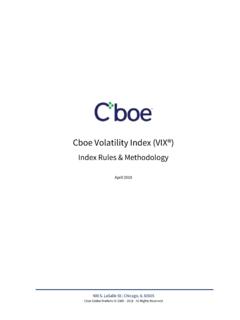Transcription of Introduction to ARCH & GARCH models
1 University of IllinoisDepartment of EconomicsEcon 472 Fall 2001 Optional TA HandoutTA Roberto PerrelliIntroduction to ARCH & GARCH modelsRecent developments in financial econometrics suggest the use of nonlineartime series structures to model the attitude of investors toward risk and ex-pected return. For example, Bera and Higgins (1993, ) remarked that a major contribution of the ARCH literature is the finding that apparentchanges in the volatility of economic time series may be predictable andresult from a specific type of nonlinear dependence rather than exogenousstructural changes in variables. Campbell, Lo, and MacKinlay (1997, ) argued that it is both logi-cally inconsistent and statistically inefficient to use volatility measures thatare based on the assumption of constant volatility over some period whenthe resulting series moves through time. In the case of financial data, forexample, large and small errors tend to occur in clusters, , large returnsare followed by more large returns, and small returns by more small suggests that returns are serially dealing with nonlinearities, Campbell, Lo, and MacKinlay (1997)make the distinction between: Linear Time Series: shocks are assumed to be uncorrelated but notnecessarily identically independent distributed (iid).
2 Nonlinear Time Series: shocks are assumed to be iid, but there isa nonlinear function relating the observed time series{Xt} t=0and theunderlying shocks,{ t} t= suggest the following structure to describe a nonlinear process:Xt=g( t 1, t 2,..) + th( t 1, t 2,..)E[Xt| t 1] =g( t 1, t 2,..)Var[Xt| t 1] =E[{(Xt E[Xt])| t 1}2]=E[{ th( t 1, t 2,..)| t 1}2]=Var[ th( t 1, t 2,..)| t 1]={h( t 1, t 2,..)}2(1)where the functiong( ) corresponds to the conditional mean ofXt, and thefunctionh( ) is the coefficient of proportionality between the innovation inXtand the shock general form above leads to a natural division in Nonlinear TimeSeries literature in two branches: models Nonlinear in Mean:g( ) is nonlinear; models Nonlinear in Variance:h( )2is to the authors, most of the time series studies concentrate inone form or another. As examples, they mention Nonlinear Moving Average Model:Xt= t+ 2t 1. Here the functiong= 2t 1and the functionh= 1.
3 Thus, it is nonlinear in mean butlinear in variance. Engle s (1982) ARCH Model:Xt= t 2t 1. The process is nonlinearin variance but linear in mean. The functiong( ) = 0 and the functionh= 2t such motivations, Engle (1982) proposed the following model tocapture serial correlation in volatility : 2= + (L) 2t(2)where (L) is the polynomial lag operator, and t| t 1 N(0, 2t 1) is theinnovation in the asset return. Bera and Higgins (1993) explained that theARCH model characterizes the distribution of the stochastic error tcondi-tional on the realized values of the set of variables t 1={yt 1,xt 1,yt 2,xt 2,..}.2 Computational problems may arise when the polynomial presents a highorder. To facilitate such computation, Bollerslev (1986) proposed a Gener-alized Autorregressive Conditional Heteroskedasticity ( GARCH ) model, 2t= + (L) 2t 1+ (L) 2t(3)It is quite obvious the similar structure of Autorregressive Moving Average(ARMA) and GARCH processes: a GARCH (p, q) has a polynomial (L)of order p - the autorregressive term, and a polynomial (L) of order q - the moving average and Interpretations of ARCH ModelsFollowing Bera and Higgins (1993), two important concepts should be intro-duced at this point:Definition 1(Law of Iterated Expectations): Let 1and 2be two setsof random variables such that 1 2.
4 Let Y be a scalar random ,E[Y| 1] =E[E[Y| 2]| 1].Note(Conditionality versus Inconditionality): If 1= , thenE[E[Y| 2]] =E[Y].Without loss of generality, let a ARCH (1) process be represented byut= t 0+ 1u2t 1(4)where{ t} t=0is a white noise stochastic process. Johnston and DiNardo(1997) briefly mention the following properties of ARCH models : uthave mean :ut= t 0+ 1u2t 1Et 1[ut]=Et 1[ t] 0+ 1u2t 1= 0Et 2Et 1[ut] = 0(..)E[ut]= 0(5)3 uthave conditional variance given by 2t= 0+ 1u2t :u2t= 2t[ 0+ 1u2t 1]Et 1[u2t] = 2 [ 0+ 1u2t 1]= 1[ 0+ 1u2t 1]= 2t(6) uthave unconditional variance given by 2= 01 :Et 2Et 1[u2t]=Et 2[ 0+ 1u2t 1]= 0+ 1Et 2[u2t 1]= 0+ 0 1+ 21u2t 2Et 3Et 2Et 1[u2t]=Et 3[ 0+ 0 1+ 21u2t 2]= 0+ 0 1+ 21Et 3[u2t 2]= 0+ 0 1+ 0 21+ 31ut 3(..)E0E1E2(..)Et 2Et 1[u2t] = 0(1 + 1+ 21+..+ t 11) + t1u20= 01 1= 2(7)Therefore, unconditionally the process isHomoskedastic. uthave :Et 1[utut 1] =ut 1Et 1[ut] = 0(8)Regarding kurtosis, Bera and Higgins (1993) show that the process has aheavier tail than the Normal distribution, given thatE[ 4t] 4 = 3(1 211 3 21)>3(9)Heavy tails are a common aspect of financial data, and hence the ARCH models are so popular in this field.
5 Besides that, Bera and Higgins (1993)mention the following reasons for the ARCH success:4 ARCH models are simple and easy to handle ARCH models take care of clustered errors ARCH models take care of nonlinearities ARCH models take care of changes in the econometrician s ability toforecastIn fact, the last aspect was pointed by Engle (1982) as a random coeffi-cients problem: the power of forecast changes from one period to the history of ARCH literature, interesting interpretations of processcan be found. : Lamoureux and Lastrapes(1990). They mention that the conditionalheteroskedasticity may be caused by a time dependence in the rate ofinformation arrival to the market. They use the daily trading volumeof stock markets as a proxy for such information arrival, and confirmits significance. Mizrach (1990). He associates ARCH models with the errors of theeconomic agents learning processes. In this case, contemporaneouserrors in expectations are linked with past errors in the same expec-tations, which is somewhat related with the old-fashioned adaptableexpectations hypothesis in macroeconomics.
6 Stock (1998). His interpretation may be summarized by the argumentthat any economic variable, in general, evolves an on operational timescale, while in practice it is measured on a calendar time scale. Andthis inappropriate use of a calendar time scale may lead to volatilityclustering since relative to the calendar time, the variable may evolvemore quickly or slowly (Bera and Higgins, 1990, p. 329; Diebold,1986].Estimating and Testing ARCH ModelsJohnston and DiNardo (1997) suggest a very simple test for the presence ofARCH problems. The basic menu (step-by-step) is: Regressyonxby OLS and obtain the residuals{ t}.5 Compute the OLS regression 2t= 0+ 1 2t 1+..+ p 2t p+error. Test the joint significance of 1,.., case that any of the coefficients are significant, a straight-forwardmethod of estimation (correction) is provided by Greene (1997). It consistsin a four-step FGLS: Regressyonxusing least squares to obtain and vectors.)
7 Regress 2ton a constant and 2t 1to obtain the estimates of 0and 1,using the whole sample (T). Denote [ 0, 1] = . Computeft= 0+ 1 2t 1. Then compute theasymptotically effi-cientestimate , = +d , whered is the least squares coefficientvector in the regression[( 2tft) 1] = z0(1ft) + z1( 2t 1ft) +error(10)The asymptotic covariance matrix for is 2( z z) 1, where zis theregressor vector in this regression. Recomputeftusing ; then computert= [1ft+ 2( 1 tft+1)2]1/2st=1ft 1ft+1[ 2t+1ft+1 1](11)Compute the estimate = +d , whered is the least squarescoefficient vector in the regression[ tstrt] = wxtrt+error(12)Theasymptoticcovariance matrix for is given by ( w w) 1, where wisthe regressor vector on the equation [1] Bera, A. K., and Higgins, M. L. (1993), ARCH models : Properties,Estimation and Testing, Journal of Economic Surveys, Vol. 7, No. 4,307-366.[2] Bollerslev, T. (1986), Generalized Autorregressive Conditional Het-eroskedasticity, Journal of Econometrics, 31, 307-327.
8 [3] Campbell, J. Y., Lo, A. W., and MacKinlay, A. C. (1997),The Econo-metrics of Financial Markets, Princeton, New Jersey: Princeton Uni-versity Press.[4] Diebold, F. X. (1986), Modelling the persistence of Conditional Vari-ances: A Comment, Econometric Reviews, 5, 51-56.[5] Engle, R. (1982), Autorregressive Conditional Heteroskedasticity withEstimates of United Kingdom Inflation ,Econometrica, 50, 987-1008.[6] Greene, W. (1997),Econometric Analysis, Third Edition, New Jersey:Prentice-Hall.[7] Johnston, J., and DiNardo, J. (1997),Econometric Methods, FourthEdition, New York: McGraw-Hill.[8] Lamoureux, G. C., and Lastrapes, W. D. (1990), Heteroskedasticityin Stock Return Data: Volume versus GARCH Effects, Journal of Fi-nance, 45, 221-229.[9] Mizrach, B. (1990), Learning and Conditional Heteroskedasticity inAsset Returns, Mimeo,Department of Finance, The Warthon School,University of Pennsylvania.[10] Stock, J.
9 H. (1988), Estimating Continuous-Time Processes Subjectto Time Deformation, Journal of the American Statistical Association(JASA), 83.











